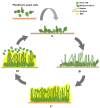Biofilm: The invisible culprit in catheter-induced candidemia
- PMID: 37649801
- PMCID: PMC10462453
- DOI: 10.3934/microbiol.2023025
Biofilm: The invisible culprit in catheter-induced candidemia
Abstract
Candidemia is the most common form of invasive fungal infection associated with several risk factors, and one of them is the use of medical devices, to which microbial biofilms can attach. Candidemia related to the use of peripheral intravascular and central venous catheters (CVC) is referred to as Candida catheter-related bloodstream infection, with more than 90% being related to CVC usage. The infection is associated with a higher morbidity and mortality rate than nosocomial bacterial infections. Candida spp. can protect themselves from the host immune system and antifungal drugs because of the biofilm structure, which is potentiated by the extracellular matrix (ECM). Candida albicans and Candida parapsilosis are the most pathogenic species often found to form biofilms associated with catheter usage. Biofilm formation of C. albicans includes four mechanisms: attachment, morphogenesis, maturation and dispersion. The biofilms formed between C. albicans and non-albicans spp. differ in ECM structure and composition and are associated with the persistence of colonization to infection for various catheter materials and antifungal resistance. Efforts to combat Candida spp. biofilm formation on catheters are still challenging because not all patients, especially those who are critically ill, can be recommended for catheter removal; also to be considered are the characteristics of the biofilm itself, which readily colonizes the permanent medical devices used. The limited choice and increasing systemic antifungal resistance also make treating it more difficult. Hence, alternative strategies have been developed to manage Candida biofilm. Current options for prevention or therapy in combination with systemic antifungal medications include lock therapy, catheter coating, natural peptide products and photodynamic inactivation.
Keywords: biofilm; candidemia; catheter; extracellular matrix; treatment.
© 2023 the Author(s), licensee AIMS Press.
Conflict of interest statement
Conflict of interest: The authors declare no conflict of interest that could affect the publication of this review article.
Figures
Similar articles
-
Combination of Systemic and Lock-Therapies with Micafungin Eradicate Catheter-Based Biofilms and Infections Caused by Candida albicans and Candida parapsilosis in Neutropenic Rabbit Models.J Fungi (Basel). 2024 Apr 17;10(4):293. doi: 10.3390/jof10040293. J Fungi (Basel). 2024. PMID: 38667964 Free PMC article.
-
The Role of Antifungals against Candida Biofilm in Catheter-Related Candidemia.Antibiotics (Basel). 2014 Dec 25;4(1):1-17. doi: 10.3390/antibiotics4010001. Antibiotics (Basel). 2014. PMID: 27025612 Free PMC article. Review.
-
Antifungal catheter lock therapy for the management of a persistent Candida albicans bloodstream infection in an adult receiving hemodialysis.Pharmacotherapy. 2014 Jul;34(7):e120-7. doi: 10.1002/phar.1433. Epub 2014 Apr 30. Pharmacotherapy. 2014. PMID: 24782326
-
Association of different Candida species with catheter-related candidemia, and the potential antifungal treatments against their adhesion properties and biofilm-forming capabilities.J Clin Lab Anal. 2021 Apr;35(4):e23738. doi: 10.1002/jcla.23738. Epub 2021 Feb 19. J Clin Lab Anal. 2021. PMID: 33608902 Free PMC article.
-
Candida and candidaemia. Susceptibility and epidemiology.Dan Med J. 2013 Nov;60(11):B4698. Dan Med J. 2013. PMID: 24192246 Review.
Cited by
-
Antifungal resistance: why are we losing this battle?Future Microbiol. 2024;19(11):1027-1040. doi: 10.1080/17460913.2024.2342150. Epub 2024 Jun 21. Future Microbiol. 2024. PMID: 38904325 Free PMC article. Review.
-
Epidemiology risk factors and antifungal resistance patterns of Candida in cancer patients in Jiangxi China.Front Microbiol. 2025 Jul 22;16:1630226. doi: 10.3389/fmicb.2025.1630226. eCollection 2025. Front Microbiol. 2025. PMID: 40766085 Free PMC article.
-
Recent Challenges in Diagnosis and Treatment of Invasive Candidiasis in Neonates.Children (Basel). 2024 Sep 30;11(10):1207. doi: 10.3390/children11101207. Children (Basel). 2024. PMID: 39457172 Free PMC article. Review.
-
Perspectives on the Use of Echinocandins in the Neonatal Intensive Care Unit.Antibiotics (Basel). 2024 Dec 12;13(12):1209. doi: 10.3390/antibiotics13121209. Antibiotics (Basel). 2024. PMID: 39766599 Free PMC article. Review.
-
Establishment and Validation of a Nomogram Clinical Prediction Model for Nosocomial Candidemia: An 18-Year Retrospective Analysis.Infect Drug Resist. 2024 Oct 16;17:4455-4466. doi: 10.2147/IDR.S480028. eCollection 2024. Infect Drug Resist. 2024. PMID: 39431215 Free PMC article.
References
Publication types
LinkOut - more resources
Full Text Sources
Miscellaneous

